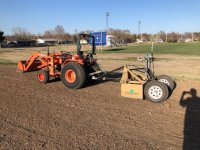npalen
Elite Member
I've done a lot of business process automation. The thing I like to tell people is you have to be able to do it manually before you can automate it. So I would work on getting it manual before trying to automate it. Here's what I mean: try putting an electric control on the blade height adjustment with two buttons, one for up and one for down. Can you come up with a simple set of rules based on just the lights from the level that allows you to do the job? An example of simple rules might be, if the "high" light comes on, push the "down" button until the light goes off and if the "low" light comes on push the "up" button until the light goes off. A more complicated set of rules might be if the "high" light comes on, push the "down" button for one second and then check the "high" light.
Does that set of rules give you the result you want, with all terrain, soil conditions and speeds? Because if you can't come up with a set of rules that allows you to get good results with you acting as the computer, the actual computer is never going to be smarter than you. If it turns out that you need additional information -- speed, soil type -- you need either additional inputs (speed sensor) or a way for the user to input settings into the computer.
This approach also allows you to attack the problem in a divide-and-conquer way which allows you to work methodically. You'll never get something like this working if you try to do everything at once. I could see a process with the following steps:
1. Implement electric control of blade height with manual switches.
2. Devise rules for controlling blade height based on height sensor (and other sensors and inputs as necessary) using manual switches.
3. Devise way for reading height sensor from computer (and other sensors as necessary).
4. Devise way of activating blade control from computer.
5. Program computer to follow rules, read sensors and control blade.
I agree 100% with what you're saying here and been thinking about this while giving the valve lever a few quick "hits" to bring the light back to green. (on grade) I have a relatively large bore cylinder at 3 1/2" x 8" stroke so it takes a few good hits with about 3-4 GPM (GallonsPerMinute) with engine running not even half throttle.
Another control issue is what happens when the laser calls for "blade down" and the ground is so hard or the box is so full that it doesn't go down but continues to "ride high". From what I've seen on videos of operators running the automatic units is that they keep their finger on the manual/auto switch at all times ready to take charge of this situation. Part of the solution can be pre-tillage to make sure enough loose dirt is available.
I normally run my box blade on the 3PH but decided to put the tongue on this afternoon and did some grading on this practice field that is going to be planted to Buffalo in a couple months. Its a contoured terrain so not able to use the laser here. There are, however, laser levels with "high in the center" capability. I can see where GPS contouring would have its place but oh the dollars.
Its interesting to compare the pros and cons of running 3PH verses tongue pull. Maneuverability is better in some cases with the tongue as can turn shorter since I don't have castering gauge wheels on the box blade. Backing up into tight places is, of course, easier with the 3PH mode.

